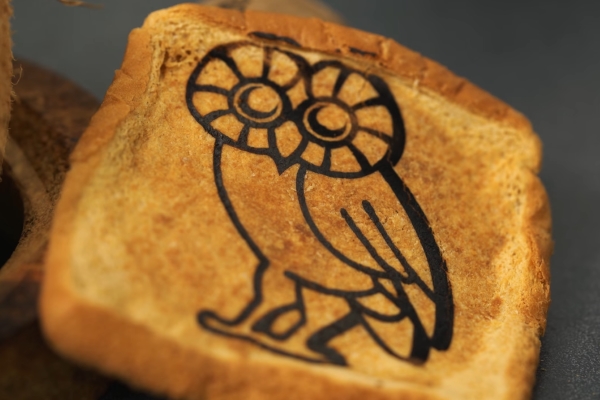
University researchers have found a way to brand food with edible electronics, paving the way for a new class of identification tags that could help fight food fraud.
The “tattoo”, investigated by scientists at US-based Rice University, is a pattern of any design that can be drawn onto food and other materials, such as paper and cloth, and results from a laser converting the subject material into graphene.
Graphene is the 2D form of carbon and exists as a one-atom thick hexagonal lattice of carbon atoms that is 200 times stronger than steel. The material is safe to eat and has the ability to conduct electricity.
The work, which demonstrated that laser-induced graphene can be burned into paper, cardboard, cloth, coal and certain foods such as toast and potatoes, is published in the American Chemical Society journal ACS Nano.
“This is not ink,” James Tour, head of the Rice Lab who is leading the research, said in a statement. “This is taking the material itself and converting it into graphene.”
According to the researchers, laser-induced graphene can be written into target materials in patterns and, because of its electrical conductivity, can be used as a supercapacitor, an electrocatalyst for fuel cells, radio-frequency identification (RFID) antennas and biological sensors, among other applications.
“Very often, we don’t see the advantage of something until we make it available,” Tour said. “Perhaps all food will have a tiny RFID tag that gives you information about where it’s been, how long it’s been stored, its country and city of origin and the path it took to get to your table.”
Furthermore, laser-induced graphene tags could also act as sensors to detect E. coli and other micro-organisms in food to improve food safety and reduce food contamination. “The tags could light up and give you a signal that you don’t want to eat this. All that could be placed not on a separate tag on the food, but on the food itself,” Tour said.
The current technique is an enhancement of a previous investigation by the researchers that turned Girl Scout biscuits into graphene. In both cases, the scientists hold the premise that any material with the right carbon content can be converted into graphene.
The technique involves multiple laser passes with a defocused beam in air at ambient temperatures.
Tour said that defocusing the laser sped up the process as the wider beam allowed each spot on a target to be lased many times in a single raster scan. As a result, branding can take just seconds.
In most cases, multiple lasing was found to create a two-step reaction, Tour said. “First, the laser photothermally converts the target surface into amorphous carbon [like burnt toast]. Then on subsequent passes of the laser, the selective absorption of infrared light turns the amorphous carbon into laser-induced graphene. We discovered that the wavelength clearly matters.”
The common element that allows graphene to be burnt into food is lignin, a complex organic polymer that forms rigid cell walls in plants, and which acts as a carbon precursor. Cork, coconut shells and potato skins all have high levels of lignin, making them particularly adept at being converted into graphene.
Besides tackling food fraud, the scientists believe the technique has a number of applications, including wearable electronics embedded in clothing or RFID tags directly embedded on cardboard boxes for tracking.
The researchers plan to commercialise the technology.
The laser-induced graphene tag follows technology announced by Lancaster University last year, where unique quantum ID tags were generated from graphene, which could be scanned by a smartphone. The scientists said the tags were virtually impossible to copy and could be fitted to any surface or product as a means to ensure authenticity.
©
SecuringIndustry.com





